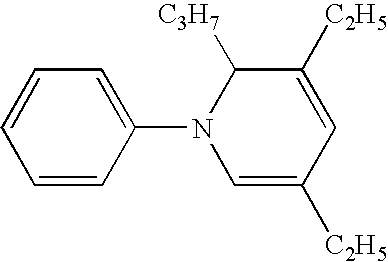Process for the preparation of 3,5-diethyl-1,2-dihydro-1-phenyl-2-propylpyridine
a technology of dihydro-1,2-phenyl and pyridine, which is applied in the field of production of aminealdehyde condensation products, can solve the problems of low bond strength, difficult decomposition of dhp, and difficult addition of additives, so as to achieve the effect of reducing the decomposition of dhp and improving the production of dhp
- Summary
- Abstract
- Description
- Claims
- Application Information
AI Technical Summary
Benefits of technology
Problems solved by technology
Method used
Image
Examples
example i
[0026] DHP was prepared using methods consistent with the methods in the literature. A 1000 mL four neck flask was equipped with a mechanical stirrer, a reflux condenser, a thermometer, and an addition funnel. An ice-water bath was used to cool the flask as needed. The flask was charged with 86 g de-ionized water, 9.8 g (0.16 mole) acetic acid, and 216 g (3.0 mol) butyraldehyde. With cooling and stirring, 60 g (0.64 mole) aniline was added over a 35-minute period while maintaining the reaction temperature at 20° C. The reaction mixture was stirred for one hour at less than 25° C. The reaction mixture was then heated to 75° C. and held for two hours. Finally, the reaction mixture was heated to reflux (90° C.) and was held for five hours. The reaction mixture was cooled and the layers were separated. The top, organic layer was distilled through a 14″ packed column under reduced pressure. The fraction taken at a head temperature of 140-143° C. and 5 mm Hg pressure weighed 104 grams and...
example ii
[0027] A 1000 mL flask was equipped in the same matter as above. With stirring and cooling, the flask was charged with 433 grams (6.0 mole) butyraldehyde, 120 grams (1.3 mole) aniline, and 9.8 grams acetic acid (0.16 mole). The mixture was maintained at 20-25° C. as each reactant was added, after which the reaction temperature slowly increased to 40° C. The reaction mixture was allowed to stir for one hour at 40° C. then heated to 75° C. and held for five hours. A solution of 10% aqueous sodium carbonate (100 mL) was added to the flask and the reaction mixture was heated to reflux and held for additional five hours. The reaction mixture was cooled and the layers were separated. The top, organic layer was distilled through a 14″ packed column under reduced pressure. The product cut was taken at a head temperature of 140-143° C. and 4 mm Hg pressure weighed 219 grams was analyzed to contain 89% DHP, which translates to an overall chemical yield of 59%.
example iii
[0028] Several parameters were changed between Example I and Example II. To isolate the effects of each parameter, a series of runs was made wherein in each run only one parameter was changed. As shown in Table 1, runs were made to compare the reaction temperature after completion of the addition of the reactants and the effect of neutralizing the reaction mixture prior to refluxing. All reported yields are based on the weight of the recovered top layer from the reaction mixtures and a gas chromatograph (GC) analysis of the top layer. Thus, these are chemical yields of DHP made and not isolated recovered yields.
TABLE 1Run #345121 hr @ 5 hr @ 75 C.5 hr @ 75 C.5 hr @ reflux5 hr @ 75 C.5 hr @ 75 C. 5 hr @ reflux5 hr @ refluxReactants:Butyraldehyde216.3 g216.3 g216.3 g216.3 g216.3 g (3.0 mole) (3.0 mole) (3.0 mole) (3.0 mole) (3.0 mole)Aniline 60.0 g 60.0 g 60.0 g 60.0 g 60.0 g(0.64 mole)(0.64 mole)(0.64 mole)(0.64 mole)(0.64 mole)Acetic Acid 9.8 g 9.8 g 9.8 g 9.8 g 9.8 g(0.16 mole)(...
PUM
| Property | Measurement | Unit |
|---|---|---|
| temperature | aaaaa | aaaaa |
| temperature | aaaaa | aaaaa |
| temperature | aaaaa | aaaaa |
Abstract
Description
Claims
Application Information
 Login to View More
Login to View More - R&D
- Intellectual Property
- Life Sciences
- Materials
- Tech Scout
- Unparalleled Data Quality
- Higher Quality Content
- 60% Fewer Hallucinations
Browse by: Latest US Patents, China's latest patents, Technical Efficacy Thesaurus, Application Domain, Technology Topic, Popular Technical Reports.
© 2025 PatSnap. All rights reserved.Legal|Privacy policy|Modern Slavery Act Transparency Statement|Sitemap|About US| Contact US: help@patsnap.com

